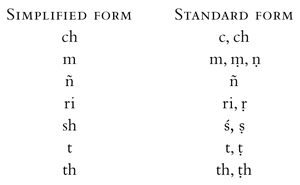

TRANSLITERATION AND PRONUNCIATION
Spellings of Sanskrit words are simplified, and diacritical marks are omitted in the main text. Macrons (to indicate long vowels) and tilde for ñ in Sanskrit words are used only in the glossary.

Chinese terms are spelled according to the pinyin system. In the following list, the right column gives approximate English pronunciations of unusual letters used in the pinyin system (in the left column):
c |
ts |
q |
ch |
x |
sh |
zh |
j |
In Japanese words, macrons over long vowels appear for the most part only in the glossary. Macrons are also used in names of texts in the section titled “Texts in Relation to Dogen’s Life and Translation Credits.” The name Dogen is pronounced with hard g as in gate.
NAMES
For Japanese names of laypeople, we put the given name first, to conform with English usage; this order is reversed when the names are alphabetized in the glossary and bibliography. The order is not reversed for Buddhist names, such as Eihei Dogen and Chinese laypeople’s names. The abbots of Zen monasteries are often referred to by the name of the mountain, monastery, or region where they resided (as in the example of Eihei Dogen of the Eihei Monastery). Similarly, many monasteries are named after the mountains on which they were built.
TIME, DATES, AND THE BUDDHA’S DATES
Years in this book are dated according to the common era (C.E.) and before the common era (B.C.E.), but in referring to months we follow the lunar calendar traditionally used in East Asia. The first to third months correspond to spring, and the other seasons follow in three-month periods. The fifteenth day of each month is the day of the full moon. The lunar calendar occasionally adds an extra month in order to synchronize with the solar year. Even though approximately thirty days of the end of each lunar year run into the next solar year, to avoid confusion, we accord the entire lunar year to its corresponding solar year.
In the traditional East Asian system, a day has twelve hours. The time from sunrise to sunset is divided into six hours. The nighttime is also made up of six hours. In accordance with the movement of the sunrise and sunset, the length of hours in daytime and nighttime change. The diagrams in appendix 8 illustrate the division of the day into portions, according to which monastic practices are performed in an orderly manner.
Traditional East Asian understanding of Shakyamuni Buddha’s dates is different from that of contemporary scholars. See Buddha, Shākyamuni in the glossary for details.
People’s ages are reckoned according to the traditional East Asian approach, whereby a person is one year old at birth and gains a year on New Year’s Day of the East Asian lunar calendar, not on one’s birthday.
UNITS OF MEASUREMENT
Please see the glossary at the end of volume two for traditional Asian measuring units that appear in the text.